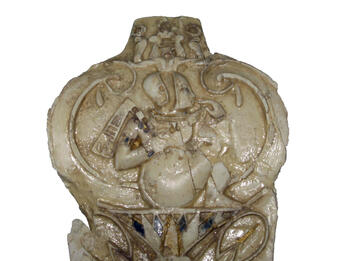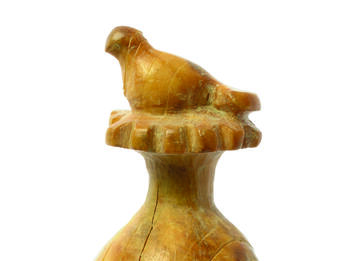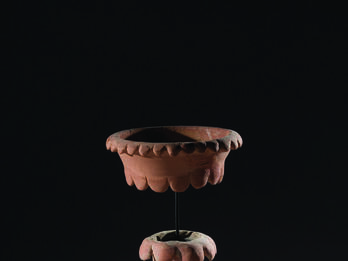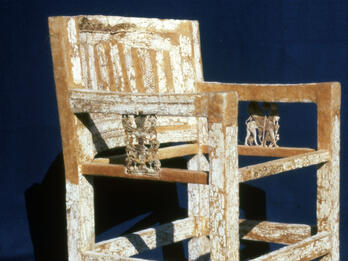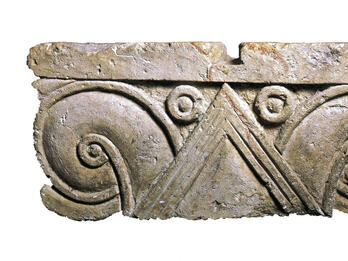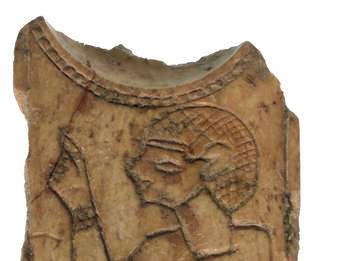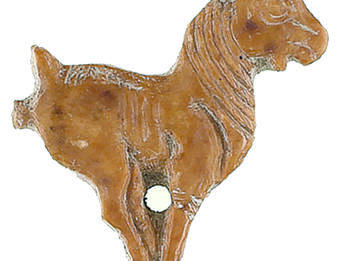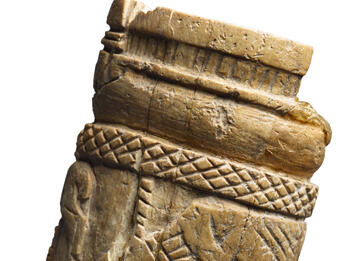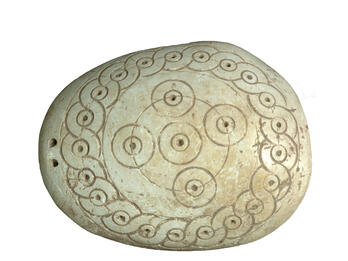Showing Results 21 - 30 of 37
Restricted
Image
This leaf-shaped ivory relief from Samaria depicts Horus as a child sitting on a lotus flower. The lotus was a symbol of regeneration, and because, in Egyptian belief, each pharaoh was considered an…
Places:
Samaria, Land of Israel (Samaria, Israel)
Date:
Iron Age IIA–IIB, 9th–8th Century BCE
Subjects:
Categories:
Restricted
Image
This small sculpture of a pomegranate with a bird (most likely a dove) sitting on top is from the City of David in Jerusalem. The sculpture was probably mounted on a piece of furniture (fragments of…
Places:
City of David, Land of Israel (Jerusalem, Israel)
Date:
Iron Age II, 9th–8th Century BCE
Subjects:
Categories:
Restricted
Image
This limestone cosmetic bowl from Megiddo has mosaic decoration around the rim. It consists of alternating circular and bud-shaped inlays of blue and brown glass. Some are now missing. The central…
Places:
Megiddo, Land of Israel (Tel Megiddo, Israel)
Date:
Iron Age II, 8th–7th Century BCE
Subjects:
Categories:
Restricted
Image
The chalice, covered with red slip (a thin mixture of red clay and water), consists of a tall, hollow stand and a separate bowl; both parts are decorated with downturned petals. Together they stand…
Places:
Arad, Land of Israel (Tel ‘Arad, Israel)
Date:
Iron Age IIA (?)–IIB, 9th (?)–8th Century BCE
Subjects:
Categories:
Restricted
Image
Ivory-inlaid chair, Salamis, Cyprus, 8th or 7th century BCE. Among the most beautiful items surviving from Israel and neighboring countries are the ivory carvings used for decorating furniture, among…
Places:
Salamis, Cyprus (Famagusta, Cyprus)
Date:
Iron Age II, 8th–7th Century BCE
Subjects:
Categories:
Restricted
Image
The palm and the palmette are common iconographic elements in ancient Near Eastern art, appearing, for example, in ivory decoration (see Ivory and Bone Carvings and Engraved Seashells) and in Assyrian…
Places:
Ramat Rahel, Land of Israel (Ramat Rahel, Israel)
Date:
Iron Age II, Late 8th–Early 7th Century BCE
Subjects:
Categories:
Restricted
Image
This spoon from Hazor has a wide handle intricately incised on its front with a sequence of palmettes curving upward instead of the more common downward-turning volutes. The spoon’s use is unclear. It…
Places:
Hazor, Land of Israel (Tel Hazor, Israel)
Date:
Iron Age II, 8th Century BCE
Subjects:
Categories:
Restricted
Image
In this ivory inlay, found in Jerusalem (Ophel), incised lines indicate the goat’s fur, especially around the neck, and deeper lines detail the legs. The goat’s feet are all very close together…
Places:
Jerusalem, Land of Israel (Jerusalem, Israel)
Date:
Iron Age IIA, 10th–9th Century BCE
Subjects:
Categories:
Restricted
Image
The primary register of this handle from Hazor shows two grazing caprids (perhaps deer or gazelles), a popular motif (see “Bulla of Shebanyahu Son of Samak, with Grazing Doe”). Beneath them is a…
Places:
Hazor, Land of Israel (Tel Hazor, Israel)
Date:
Iron Age IIB, first Half of 8th Century BCE
Subjects:
Categories:
Restricted
Image
This shell from Mizpah is incised with concentric circles with dots in the center. The circles on the outer ring are combined into a guilloche. There are two perforations at one end and three (not…
Places:
Mizpah, Land of Israel (Yehud, West Bank)
Date:
Iron Age II, Early 10th–Early 6th Century BCE


